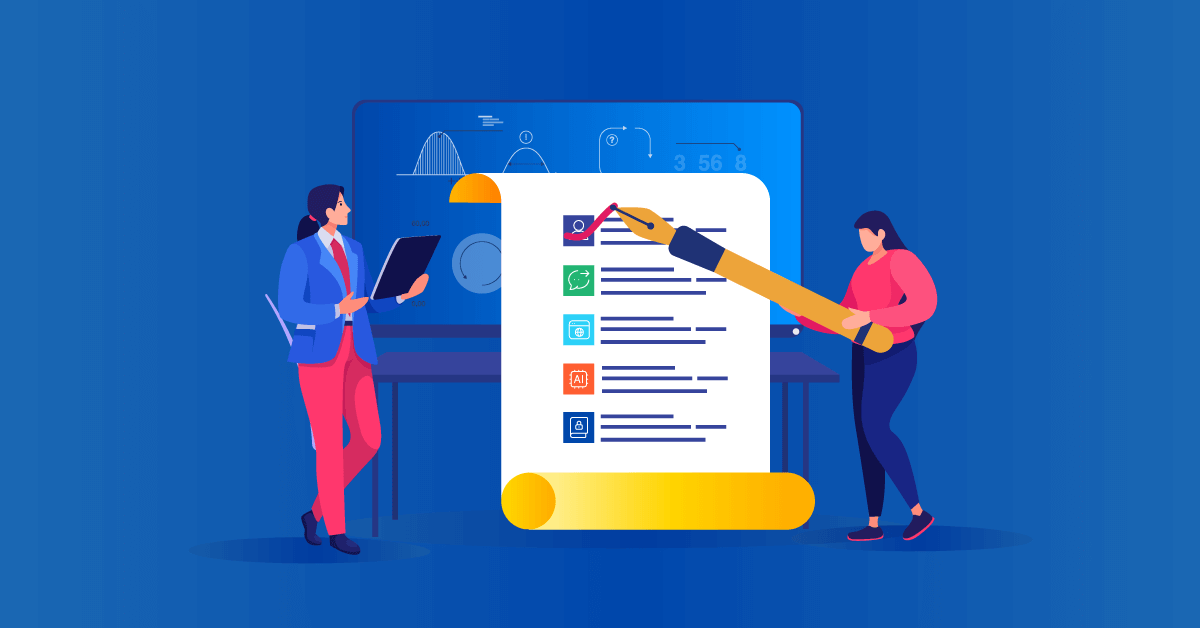- 1. Forgetting to run a training needs analysis
- 2. Choosing the wrong eLearning tools
- 3. Not re-evaluating your training objectives
- 4. Using the same online training resources
- 5. Not getting the right people on board
- 6. Overlooking the importance of employee feedback
- 7. Implementing a one-size-fits-all strategy
- 8. Overloading employees with too much information
Learning technologies have many advantages. They give employees access to online training resources from anywhere in the world, whenever it fits into their schedule. This also helps to improve your company’s profit margin and on-the-job productivity.
However, when you’re making the leap to online training, it’s best to prepare for every situation. Unexpected challenges may put you out of schedule and force you to second-guess your decision. At the very least, this might cause unnecessary stress for your entire L&D team and put you over budget.
To ensure a smooth transition from traditional to online training and achieve the best ROI, here are 8 common mistakes to avoid.
1. Forgetting to run a training needs analysis
Organizations make the switch from traditional to online training for many different reasons. But one of the most common is that they want to bridge gaps that their current training strategy is unable to fill.
To achieve this, you must first run a training needs analysis to evaluate the weaknesses and strengths of your traditional program. What skills or knowledge do employees currently lack? How will learning technologies help them improve performance and productivity? Determine how online training will fit into your overall L&D strategy and ease your current pain points.
2. Choosing the wrong eLearning tools
Many organizations make the mistake of investing in eLearning tools and Learning Management Systems before researching all the options. They want to set up their online training program as quickly as possible, or cut costs by selecting eLearning authoring tools with basic features that end up falling short. But if the tools they choose end up being a poor fit, they eventually spend time and resources to look for replacements.
While on the hunt for new training tools, don’t forget to research online reviews, contact LMS vendors, and ask for recommendations. It’s also a good idea to narrow down your options by reading user reviews.
3. Not re-evaluating your training objectives
The needs and requirements of your organization change over time. The same goes for your employees. You can’t embark on your new eLearning venture without first re-evaluating your training goals and objectives. For example, training objectives that were at the top of your priority list a year ago may no longer be relevant.
In addition, learning technologies give you access to even more big data that you can use to measure L&D. As such, you may be able to set more accurate goals that align with your current business needs.
4. Using the same online training resources
It’s perfectly acceptable to repurpose your online training materials, but not without making adjustments. Evaluate your online assets and determine how modern technology can make them even more engaging and interactive.
For example, that outdated PowerPoint presentation may not be the best choice for today’s corporate learners. But a good eLearning authoring tool can help you transform it into an appealing simulation or microlearning online training module. And this also helps you get more from your online training investment.

5. Not getting the right people on board
You need to put together an effective L&D team to create an online training strategy. They’ll handle the data migration, content repurposing, report monitoring, and countless other essential tasks.
However, you need to have the right people on board to get the best results. Preferably, at least one person from every department should be on your L&D team, plus experienced eLearning professionals, ranging from Instructional Designers to Subject Matter Experts. You should also equip them with an eLearning Project Management tool that will gather all communication channels in one and help them stay on track.
6. Overlooking the importance of employee feedback
Employees should play an integral role in your online training program, whether it be online or off. Get them involved from day one, so they can offer their feedback and help you develop more meaningful online training content.
When making the switch from traditional to online training, create focus groups to see how your online training courses will be received. It’s also wise to carry out assessments and surveys. These will personalize online training resources to address employee gaps and areas for improvement.
7. Implementing a one-size-fits-all strategy
Online training gives your organization the ability to deliver targeted training content to every member of your team. In fact, one of the perks that win most stakeholders over is avoiding a one-size-fits-all strategy which comes from implementing learning technologies.
Everyone has different needs and work responsibilities that your online training must accommodate. You need to custom-tailor your online training content based on departments, roles, and tasks to ensure that employees get the most out of their training.
8. Overloading employees with too much information
Online training gives employees access to an abundance of information. They can simply log in to the platform to watch online training tutorials, complete certification courses, and participate in simulations. No more geographical limitations or scheduled online training sessions to limit their potential.
However, that sudden influx of ideas and concepts may not be easily digestible. So, how do you fix it? Break your content into chunks and create a microlearning online training library that makes the training process more convenient and memorable. For example, a series of 5-minute modules that cover various aspects of your skill-based training instead of an hour-long online training course.
Another great way to improve knowledge retention is by creating personalized online training paths that allow employees to choose their own activities.
Over to you
Moving from traditional to online training can be daunting. However, learning from others’ mistakes can help you avoid them and keep your implementation timeline on track. Have any advice on what others should avoid when switching to online training? Leave a comment below.



